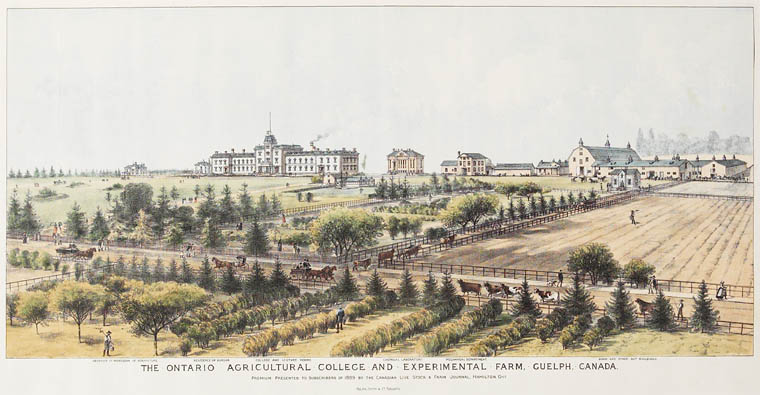|
CFRU-FM
CFRU-FM, airing at 93.3 on the FM dial, is a campus radio station based at the University of Guelph in Guelph, Ontario, Canada. CFRU is a volunteer-run campus and community radio station. CFRU is a member of the National Campus and Community Radio Association. The station hosted the 2005 national conference of that organization. History Radio at the University of Guelph has a long history dating back to 1939 when there was a credit course in radio broadcasting offered by the Ontario Agricultural College. Radio curriculum was taught at the University of Guelph until the late 1950s. Throughout the late 1950s and early 1960s various colleges at the University of Guelph produced a half-hour radio program for CJOY in a sound booth in the Massey Hall drama practice theatre. In 1965, broadcast executive Frank Ryan, a former member of the university's Board of Governors, bequeathed the university $25,000 in his will to launch its own radio station. In 1969 Room 102 of the Physical ... [...More Info...] [...Related Items...] OR: [Wikipedia] [Google] [Baidu] |
University Of Guelph
, mottoeng = "to learn the reasons of realities" , established = May 8, 1964 ()As constituents: OAC: (1874) Macdonald Institute: (1903) OVC: (1922) , type = Public university , chancellor = Mary Anne Chambers (not yet installed) , president = Charlotte A.B. Yates , city = Guelph, Ontario , country = Canada , students = 29,923 , undergrad = 23,926 , postgrad = 3,035 , faculty = 830 , administrative_staff = 3,100 , campus = Urban , athletics_affiliations = CIS, OUA , sports_nickname = Gryphons , colours = , , affiliations = AUCC, CARL, IAU, COU, CIS, CUSID, Fields Institute, OUA, Ontario Network of Women in engineering, CBIE , endowment = CA$418 million (2021) , website = , logo ... [...More Info...] [...Related Items...] OR: [Wikipedia] [Google] [Baidu] |
National Campus And Community Radio Association
The National Campus and Community Radio Association/L'Association nationale des radios étudiantes et communautaires (NCRA/ANREC) is a non-profit organization of campus radio and community radio stations in Canada. It represents the interests of the sector to government (particularly the Canadian Radio-television and Telecommunications Commission (CRTC)) and other agencies, and promotes community radio in Canada. Since 1981, it has helped lower tariffs affecting radio stations and assisted new stations to launch, as well as to obtain operating funds. Core initiatives include GroundWire, ''Dig Your Roots'', ''!earshot'', Women’s Hands and Voices, the Community Radio Fund of Canada, sector-wide listservs, and an annual radio conference. The head office of the NCRA/ANREC is located in Ottawa. A majority of English-language campus and community radio stations in Canada are members of the NCRA. History In February 1981, the first National Campus Radio Conference (NCRC) was held ... [...More Info...] [...Related Items...] OR: [Wikipedia] [Google] [Baidu] |
Guelph
Guelph ( ; 2021 Canadian Census population 143,740) is a city in Southwestern Ontario, Canada. Known as "The Royal City", Guelph is roughly east of Kitchener and west of Downtown Toronto, at the intersection of Highway 6, Highway 7 and Wellington County Road 124. It is the seat of Wellington County, but is politically independent of it. Guelph began as a settlement in the 1820s, established by Scotsman John Galt, who was in Upper Canada as the first Superintendent of the Canada Company. He based the headquarters, and his home, in the community. The area – much of which became Wellington County – had been part of the Halton Block, a Crown Reserve for the Six Nations Iroquois. Galt would later be considered as the founder of Guelph. For many years, Guelph ranked at or near the bottom of Canada's crime severity list. However, the 2017 Crime Severity Index showed a 15% increase from 2016. Guelph has been noted as having one of the lowest unemployment rates in t ... [...More Info...] [...Related Items...] OR: [Wikipedia] [Google] [Baidu] |
Polish Language
Polish (Polish: ''język polski'', , ''polszczyzna'' or simply ''polski'', ) is a West Slavic language of the Lechitic group written in the Latin script. It is spoken primarily in Poland and serves as the native language of the Poles. In addition to being the official language of Poland, it is also used by the Polish diaspora. There are over 50 million Polish speakers around the world. It ranks as the sixth most-spoken among languages of the European Union. Polish is subdivided into regional dialects and maintains strict T–V distinction pronouns, honorifics, and various forms of formalities when addressing individuals. The traditional 32-letter Polish alphabet has nine additions (''ą'', ''ć'', ''ę'', ''ł'', ''ń'', ''ó'', ''ś'', ''ź'', ''ż'') to the letters of the basic 26-letter Latin alphabet, while removing three (x, q, v). Those three letters are at times included in an extended 35-letter alphabet, although they are not used in native words. The traditional ... [...More Info...] [...Related Items...] OR: [Wikipedia] [Google] [Baidu] |
Persian Language
Persian (), also known by its endonym Farsi (, ', ), is a Western Iranian language belonging to the Iranian branch of the Indo-Iranian subdivision of the Indo-European languages. Persian is a pluricentric language predominantly spoken and used officially within Iran, Afghanistan, and Tajikistan in three mutually intelligible standard varieties, namely Iranian Persian (officially known as ''Persian''), Dari Persian (officially known as ''Dari'' since 1964) and Tajiki Persian (officially known as ''Tajik'' since 1999).Siddikzoda, S. "Tajik Language: Farsi or not Farsi?" in ''Media Insight Central Asia #27'', August 2002. It is also spoken natively in the Tajik variety by a significant population within Uzbekistan, as well as within other regions with a Persianate history in the cultural sphere of Greater Iran. It is written officially within Iran and Afghanistan in the Persian alphabet, a derivation of the Arabic script, and within Tajikistan in the Tajik alphabet, a der ... [...More Info...] [...Related Items...] OR: [Wikipedia] [Google] [Baidu] |
Dari
Dari (, , ), also known as Dari Persian (, ), is the variety of the Persian language spoken in Afghanistan. Dari is the term officially recognised and promoted since 1964 by the Afghan government for the Persian language,Lazard, G.Darī – The New Persian Literary Language", in ''Encyclopædia Iranica'', Online Edition 2006. hence it is known as Afghan Persian or Eastern Persian in many Western sources. As Professor Nile Green remarks "the impulses behind renaming of Afghan Persian as Dari were more nationalistic than linguistic" in order to create an Afghan state narrative. Apart from a few basics of vocabulary, there is little difference between formal written Persian of Afghanistan and Iran. The term "Dari" is officially used for the characteristic spoken Persian of Afghanistan, but is best restricted to formal spoken registers. Persian-speakers in Afghanistan prefer to still call their language “Farsi,” while Pashto-speakers may sometimes refer to it as "Parsi." Fa ... [...More Info...] [...Related Items...] OR: [Wikipedia] [Google] [Baidu] |
1969 In Radio
Significant events in radio broadcasting in the year 1969 included the debuts of two documentaries on rock and roll. Events *21–23 February: ''The History of Rock and Roll'', a comprehensive 48-part documentary, debuts on KHJ in Los Angeles. Produced and hosted by Bill Drake, the series airs on the RKO General chain of stations that Drake programmed, and is nationally syndicated. *1 March: NHK begins FM broadcasting in Japan. *9 March: With the exception of '' Arthur Godfrey Time'', WTOP in Washington, DC switches to an all-news format. *11 April: Radyo Veritas, the first Catholic radio station in the Philippines, was inaugurated with Asian bishops as guests. Antonio Cardinal Samore represented Pope Paul VI. It began broadcasting on the frequency of 860 kHz, formerly assigned to DZST, another Catholic radio station formerly operated by the University of Santo Tomas. *15 June: DZME 1530 started its broadcast when the Congress authorized Capitol Broadcasting Center of Jose ... [...More Info...] [...Related Items...] OR: [Wikipedia] [Google] [Baidu] |
Heavy Metal Music
Heavy metal (or simply metal) is a genre of rock music that developed in the late 1960s and early 1970s, largely in the United Kingdom and United States. With roots in blues rock, psychedelic rock and acid rock, heavy metal bands developed a thick, monumental sound characterized by distortion (music), distorted guitars, extended guitar solos, emphatic Beat (music), beats and loudness. In 1968, three of the genre's most famous pioneers – Led Zeppelin, Black Sabbath and Deep Purple – were founded. Though they came to attract wide audiences, they were often derided by critics. Several American bands modified heavy metal into more accessible forms during the 1970s: the raw, sleazy sound and shock rock of Alice Cooper and Kiss (band), Kiss; the blues-rooted rock of Aerosmith; and the flashy guitar leads and party rock of Van Halen. During the mid-1970s, Judas Priest helped spur the genre's evolution by discarding much of its blues influence,Walser (1993), p. 6 while Motörhea ... [...More Info...] [...Related Items...] OR: [Wikipedia] [Google] [Baidu] |
Cantonese
Cantonese ( zh, t=廣東話, s=广东话, first=t, cy=Gwóngdūng wá) is a language within the Chinese (Sinitic) branch of the Sino-Tibetan languages originating from the city of Guangzhou (historically known as Canton) and its surrounding area in Southeastern China. It is the traditional prestige variety of the Yue Chinese dialect group, which has over 80 million native speakers. While the term ''Cantonese'' specifically refers to the prestige variety, it is often used to refer to the entire Yue subgroup of Chinese, including related but largely mutually unintelligible languages and dialects such as Taishanese. Cantonese is viewed as a vital and inseparable part of the cultural identity for its native speakers across large swaths of Southeastern China, Hong Kong and Macau, as well as in overseas communities. In mainland China, it is the ''lingua franca'' of the province of Guangdong (being the majority language of the Pearl River Delta) and neighbouring areas such as Guang ... [...More Info...] [...Related Items...] OR: [Wikipedia] [Google] [Baidu] |
Salsa Music
Salsa music is a style of Latin American music. Because most of the basic musical components predate the labeling of salsa, there have been many controversies regarding its origin. Most songs considered as salsa are primarily based on son montuno, with elements of Mambo (music), mambo, Latin jazz, Bomba (Puerto Rico), bomba, plena and guaracha. All of these elements are adapted to fit the basic son montuno template when performed within the context of salsa. Originally the name salsa was used to label commercially several styles of Latin dance music, but nowadays it is considered a musical style on its own and one of the staples of Latin American culture. The first self-identified salsa bands were predominantly assembled by Cubans, Cuban and Puerto Ricans, Puerto Rican musicians in New York City in the '70s. The music style was based on the late son montuno of Arsenio Rodríguez, Conjunto Chappottín and Roberto Faz. These musicians included Celia Cruz, Willie ColónRuben Blade ... [...More Info...] [...Related Items...] OR: [Wikipedia] [Google] [Baidu] |



_in_Afghanistan.jpg)
